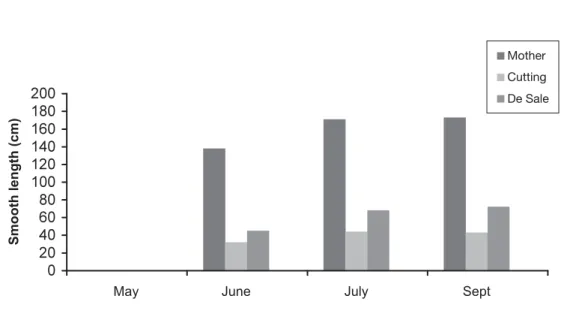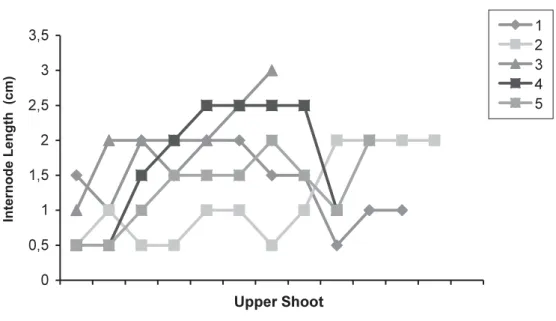V. Kefeli
1*, C. Leininger
2, B. Rehn
2,
and K. Shwarz
2*1Slippery Rock Watershed Coalition/Slippery Rock PA 16057, USA
2
Slippery Rock University, Slippery Rock PA 16057 USA
Abstract
The growth of woody plants as perennial organisms is based on the long lasting process of organs elongation and differentiation. This process proceeds on rhythmic activity of plant meristems and cambium formation. The growth is succeeded by wood and bark differentiation as well as carbon polymers formation (mostly cellulose, starch and lignin). These secondary substances are formed from the primary products of photosynthesis. Roots also play an important role of stem elongation and leaves formation. In our experimental work we investigated such basal processes as leaves growth; growth and differentiation of stems and roots regeneration. Key words: Growth, differentiation, regeneration, rhythms, wood-bark.
Introduction
Wood is a main building material for the environmental constructions. Many northern houses are made of wood, straw bells and dry stems (Kefeli and Leininger, 2006; Mikulas, 2007). Among secondary substances in wood formation, the leading role plays phenolics, as elements of lignin molecules. Low molecular phenolics could excrete from roots and accumulate as secondary substances in leaves (Kefeli et al., 2000). Some of
them play in plants the role of natural inhibitors and even botanical herbicides (Kefeli, 1992; Kefeli and Kalevitch, 2003). These low molecular weight phenolics could be antagonists to auxins (Kefeli, 2004; Kefeli et al., 2001). Leaves with phenolics after abscission play in the soil a role of carbon substrate and sometimes act as allelopathic agents (Kefeli, 2002; Kalevitch and Kefeli, 2007). This particular research deals with investigation of the growth of red willow shoots and their regenerative properties.
Materials and Methods
The primary goal of the research: Willow growth on Fabricated soil (FS) plots was investigated (Kefeli et al., 2003; Kefeli et al., 2004; Kefeli et al., 2007). Mining soil that was eroded by acid drainage was covered by the manufactured soil the mixture of organic and non-organic substrates (Kefeli and Lehringer, 2006).
Leaves formation, shoot elongation, general growth rhythms and tissue differentiation processes were studied (Sabinin, 1963). Original mother plants grew on the fabricated soil for five years in 2002-2007. Shoot cuttings were obtained (Turetskaya, 1961) of the annual shoots and later were rooted in water. After root formation was complete in Spring 2007 shoots were planted on FS. Later mother plants were transplanted from FS plots to the forest soil at the De Sale lake for the landscape rehabilitation after water cleaning. Thus three types of red willow plants were investigated through the season – mother plants, stem cuttings and willow transplants. Every month the leaves were weight in, shoot growth and elongation, bark formation (with the cambium) were studied.
Results
Leaves: General characteristics
In the fall, leaves grown on shoots of mother plants, cuttings and De Sale transplants were divided into three parts- upper, middle and lower, and the amount of the leaves and their weight was determined. The upper leaves that considered being the centers of
*Correspondence Author:
Slippery Rock, Watershead Coalition PA 16057, USA E-mail: valentin@pathway.net
Figure 1. Leaves from 1-year old willow cuttings. Willow shoot characteristics from September 25, 2007 in Jennings Plot cutting.
3 4 5
Figure 3. The seasonal growth of shoots alternated and changed within the rythmic growth way. Rythms of growth which were determined as distance between neighbouring buds.
primary products of photosynthesis had high biomass index. (Kefeli, 1992).
Leaves are the donors of monomers for carbon polymers like cellulose and lignin. Our previous observations showed that chloroplasts are also centers of primary phenolics formation. (Kefeli et al., 2003).
Willow shoot growth
Figure 2 showed that shoots of mother plants, 1 year-old cuttings and De sale transplants have the same tendency in the shoot elongation: May-June was the most intensive period of growth which than stopped at the end of July.
Figure 3. show the rythms of mother shoot growth. Mother plants top on bottom of shoot. Rhythms were determined for each shoot of the mother plant. Mother shoot was investigated in September as the other types of the shoots. The shoot growth of the cutting had a different pattern (Figure 4).
The rhythmic process of shoots growth could be changed based on plant species. Shoots of mother plants had more pikes of the growth amplitude and a longer stem growth, which brings to more pronounced process of the stem elongation. It is an important correlation between the roots growth and rhythms of shoots.
Main aspects of shoot differentiation
July is the month of the arrest of stem elongation and the beginning of bark and wood formation-accumulation. In general it is possible to establish the following chain:
1) Photosynthesis in leaves - primary photosynthetic products (sugars and amino-acids);
2) Use of primary photosynthetic products for stem elongation;
3) Role of root metabolites for rhythmic of stem (Krenke, 1950, Sabinin, 1963);
4) Formation of the C-polymers like cellulose and lignin;
5) Differentiation of bark, cambium and bark (Table 1)
Differentiation: Bark and wood growth
In our experiments we isolated only bark and wood. Cambium was connected with bark and was not separated. Thus, the whole stem (S) was divided into 2 elements – bark (B) and wood (W), see Table1.
The highest amount of wood was accumulated in the lower part of the shoots. Mother plants contained more wood than cuttings and transplants because of the intensity of roots growth. Mother plants had more developed root system and wood-bark formation.
Conclusion
This study showed the growth processes of willow shoots, including the stem elongation, its rhythmic, bark and wood formation. In general, these data are based on molecular and cellular mechanisms of carbon polymers formation like cellulose, hemi -cellulose and lignin. During the process of stem cloning and cutting propagation the process of wood and bark formation is reduced as well as the process of rhythmic correlation is not pronounced. These data are done in connection with the previous results (Boulog et al., 2004; Kefeli et al., 2003).
Objects-plants Part of shoot
Upper Middle Lower
S B W S B W S B W
Mother 3.10 1.40 1.70 7.0 2.10 4,90 10.40 2.30 8.10
Stem cutting 0.11 0.10 0.0 0.26 0.17 0,09 0.38 0.18 0.20
De Sale
transplants 0.44 0.17 0.18 0.86 0.33 0,47 1.68 0.56 0.78
soil experiment. Journal of Sustanable Agriculture. 29: 101-113, 2006.
Kefeli V. Phytohormones, genome and properties, genetics and breeding, Bulgarian academy of Sciences. 25: 213-225, 1992.
Kefeli V. Practical botany, introduction material. Slippery Rock University, USA. 1-294, 1995. Kefeli V. Fabricated Soil for Landscape Rehabilitation,
2002 SME Annual Meeting, Phoenix, Arizona, Preprint 02-142, 2002.
Kefeli V. Researchers of Plant Hormones 1995-2004. Personal Impressions, Auxin 2004. Conference Kolumpari/ Crete / Greece, 11, 2004.
Kefeli V. Water cleaning and wetland construction. International Journal of Environment and Pollution, 29: 383-391, 2007.
Kefeli V, Borsari B, Funada R, Puhn M, Shresta, M, Vasyal P and Menandhar S. Soil decomposition and fate of abscised leaves, 67 annual meeting of North East Section of American society of Plant Biologists. Recent advances in plant signal transduction, Bucknell University, 3, 2003.
Kefeli V, Borsari B, Kalevitch M and Boulos G. Auxins and root formation of stem cuttings. In: Auxin 2004. Conference Kolumpari/ Crete / Greece, 39, 2004 Kefeli V, Borsari B, Steglich C and Welton S. Botanical
herbicides and conception of selectivity 65thAnnual Meeting Northeast Section American Society of Plant Physiologists, Worchester Polytechnic Institute, Worchester, MA, 44, 2001.
Kefeli V, Dunn M, Johnson D and Taylor W. Fabricated soil and landscape rehabilitation. International Journal of Environment and Pollution. Fabricated Soil and Landscape Rehabilitation. 29: 405-411, 2007.
Kefeli V and Kalevitch M. Natural growth inhibitors and phytohormons in plants and environment. Kluwer Academic publishers,1-323, Dorderecht/Boston/ London, 2003.
Pensylvania, USA, Published by Slippery Rock Watershed Coalition, 1-112, 2006.
Kefeli V, Morrow R and Snow R. Plants roots as organs for secretion of ions and allelopathic compounds, Annual Meeting CPUB, Clarion University of Pennsylvania, 23, 2000.
Krenke NP. Plant Regeneration (Book in Russian), Moscow- Leningrad. USSR Acad. Sci, Publishers 1950.
Mikulas H. Sustainability and regeneration of ecological systems. Advances in Molecular Biology, 1: 47-48, 2007.
Sabinin DA. Physiology of Plant development; Book in Russian, Moscow USSR Academy Sci Publishers, 1963.
Turetskaya R.Kh Physiology of rooting in cutting system. Book in Russian, Moscow. USSR Acad Sci Publishers, 1961.


